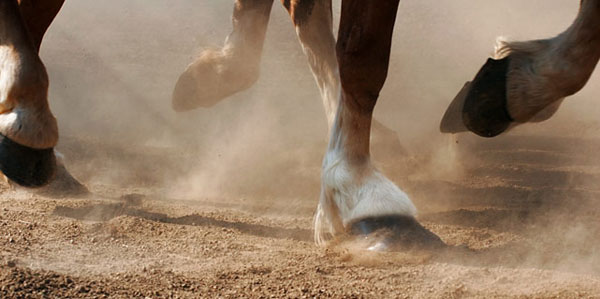Sand is the most commonly used footing due to its availability and cost effectiveness. However, sand varies widely in its physical properties and some types of sand make much better footing than others. The relevant considerations are size, shape and hardness. The size of the sand grains affects dustiness, compaction, and water retention. Ideally, arena sand should be predominantly medium coarse (0.25-0.5 mm) and coarse grains (0.5-1.0 mm). Coarse sand drains more easily than fine sand in an outdoor arena. On the other hand, sand with a lot of very fine particles is dusty when dry and compacts when it gets wet and then dries out. Angular sand grains are preferable to round grains because they lock together, forming a more stable surface that requires less maintenance. Round grains of sand tend to roll over each other like ball bearings, so the footing is less stable and more prone to shifting. Hard sand is more durable, whereas soft sand tends to break down and turn to dust after relatively little use. Hardness can be tested by placing a few grains of the sand on a hard surface and compressing them with a teaspoon. If the grains crush easily, the sand is soft.
Sand has lower impact resistance than hard soil, combined with a low shear resistance, which allows the toe of the hoof to penetrate deeply. Deep, dry sand tends to give way during push off, resulting in loss of traction, making it very tiring for the horse to work on. Trainers need to be careful to reduce the amount of exercise when changing to a deeper sand footing – otherwise there is a risk of overuse injuries to the soft tissues. When sand is wet, the grains adhere to each other due to surface tension, making it more stable and less tiring for the horse to work on than dry sand. Regular watering is recommended for deep sand arenas.
Amendments, such as rubber, wood chips, or fibers, may be added to sand to improve its properties as a riding surface. Fibers or shredded materials stabilize the sand grains. Rubber and wood products give more resilience and reduce packing. Wood products also help to hold moisture in the surface.
Bonding agents, such as water and polymers, are added to arena surfaces primarily to reduce dust. Hygroscopic agents, such as magnesium chloride, take up and retain water, so their addition to a surface reduces the frequency of watering.
Excerpt from: Footing University Equestrian Arena Footing 101
Dr. Hilary M. Clayton, BVMS, PhD, Diplomate ACVSMR, MRCVS
McPhail Dressage Chair in Equine Sports Medicine
Department of Large Animal Clinical Sciences
College of Veterinary Medicine, Michigan State University East Lansing, MI 48824-1314
Arena Mix is a 3:2 blend designed with input from local horse owners and trainers on what works well for them using the materials available locally. Made with washed All Purpose Sand and Pinewood Shavings and cuttings. Installed at a proper depth it creates a soft but stable footing for arenas and round pens. A cubic yard weighs in at 1450 lbs.


